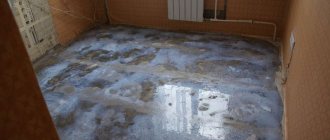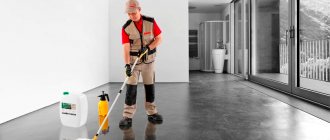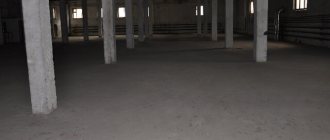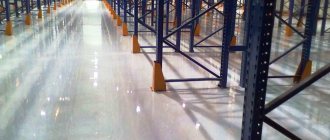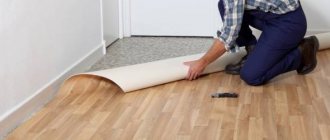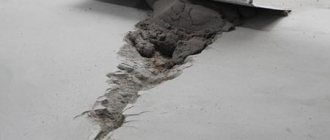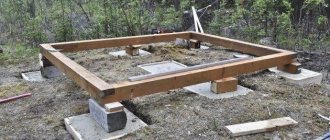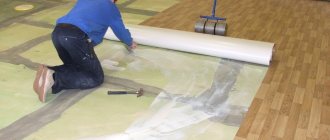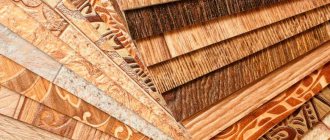Concrete floors, when poured with high quality, are very reliable and durable. They serve as an excellent base for almost any floor covering or can themselves serve as a surface to be used. But they also have a significant drawback - the formation of large amounts of dust, which often becomes a serious problem. Is it possible to remove dust from a concrete floor with your own hands?
Do-it-yourself dust removal from a concrete floor
Not only is it possible, but it is simply necessary! For this purpose, there are a number of techniques that can be used both individually and in combination.
Dust removal of a concrete floor: how to extend the service life of the base
A high-quality concrete floor is a strong, reliable and durable foundation. However, such a surface is not without drawbacks. Impregnations for concrete floors: topping to protect the coating (read more)
The main one is the formation of a large amount of dust during operation, which negatively affects people’s health, the operation of equipment and mechanisms. Dust removal from the concrete floor will help eliminate this problem; you can learn about methods to keep the concrete floor dust-free from this article.
During the operation of a concrete base, a large amount of dust appears; the problem is solved by removing dust from the floor with special impregnations.
Reasons for the formation of concrete dust
The cause of dust on the surface of a concrete floor is associated with erosion of its top layer. The structural structure of hardened concrete is represented by a pronounced conglomerate mixture, which contains dissimilar components. They differ not only in size, but also in chemical composition. The process of maturation of cement stone involves the formation of a silicate crystal lattice. It intersects with coarse-grained insoluble fillers of gravel and sand origin.
Erosion of the top layer of a concrete floor leads to the appearance of dust on its surface.
Concrete consists of many microscopic and large pores that are filled with air, water and a gel cement substance. There are also unbound chemically active substances present here, which cause erosion processes in the upper layers of concrete. This occurs with constant mechanical impact on the concrete surface, the top porous layer of which begins to collapse. Unbound particles of cement and chemically active substances turn into dust.
In addition, during the ripening process of concrete, cement laitance comes to the surface. When it hardens, it forms a weakened layer, which is often the main source of dust.
To prevent a concrete floor from becoming dusty, it is necessary to harden it, bind the top layer with a polymer mesh, crystalline components, or completely remove the upper unstable surface. To do this, there are three methods for removing dust from the surface. This includes strengthening the base using topping, treating the coating with special impregnations and sanding the floor.
Note! The best result is obtained by the comprehensive use of all technologies for dust removal of concrete surfaces.
To remove dust from a concrete floor, you can use grinding, hardening with topping, and treatment with special impregnations.
Application rules
Deep penetration impregnation has a number of features that are important to consider when working with it:
- Preliminary treatment of the concrete surface is necessary - in order to remove excess dust and contamination, as well as to ensure deeper penetration of the composition into the interior, you need to go over the surface of the concrete with an abrasive, and then remove the dust. The procedure is repeated several times to ensure the best result.
- The concrete coating must be as dry as possible - if it is a poured floor, then at least 10 days must pass after completion of the work in the presence of above-zero air temperatures and good ventilation.
- Kneading the mixture with a construction mixer - ready-made impregnations, being in a hermetically sealed container, can thicken, so before applying them it is important to stir them well, and in some cases, dilute them with a special composition.
- Step-by-step application of impregnation - if it is deep impregnation, then its task is to penetrate into the deepest layers possible. To do this, use a roller, with which the first layer is applied in excess. Allow 3-4 hours for absorption, after which the procedure is repeated. As soon as the concrete surface acquires a glossy finish, the work is completed.
Further grinding and leveling is done depending on the purpose of the concrete surface.
Why is concrete floor dust removal done?
Dust removal is the strengthening of a concrete coating using toppings, impregnations or grinding, which is carried out to extend the period of its reliable operation.
If surface erosion processes are not stopped in time, they will eventually affect deeper layers of concrete. This can lead not only to partial, but also to complete destruction of the screed.
Cement dust that forms on the surface has a negative impact on human health. Tiny particles of cement and chemicals get into the eyes and skin, causing itching. Inhalation of substances can provoke respiratory diseases and cause allergic reactions.
When the concrete floor installed in workshops, garages, and warehouses becomes dusty, the dust has a negative impact on the coordinated operation of the equipment and mechanisms installed there. This will lead to rapid wear of tools and units, which will soon fail. A crumbling concrete floor needs constant cleaning - otherwise it will have a sloppy and untidy appearance.
Dust removal of a concrete coating not only extends its service life, but also improves its aesthetic appearance.
If a concrete floor is used as a subfloor, even in this case the surface should be dust-free. If this is not done, over time the coating will begin to crunch and creak, which will cause inconvenience when using the surface.
Other ways to protect your floor
One of the long-lasting methods of dust removal is to rub a special product - topping - into the top layer of the base. It contains several components:
- Cement.
- Special filler substances.
- Binding additives.
- Additional components.
If the technology is followed, the substrate protected by the topping stops generating dust and also becomes much more durable. However, this option can hardly be called cheap. The use of special equipment, as well as not the simplest technology, makes it justified only when your floor experiences extremely high loads. In addition, the application features allow you to work only with fresh substrates. In this case, it will not be possible to repair the old foundation.
Other common methods include self-leveling floors or paint. The compositions are simply applied and do not require expensive equipment or specialists. At the same time, they not only eliminate the formation of dust, but also create a coating of the desired color. Their cost is slightly less than that of the first option, but they cannot be called affordable.
USEFUL INFORMATION: Do not exaggerate the real capabilities of the compositions. If your screed operates under difficult conditions: severe mechanical loads, liquids, base deformation, high temperatures, then it is better to pay attention to more expensive but durable products - self-leveling floors based on polyurethane or epoxy.
How to cover a concrete floor to prevent it from collecting dust in a garage or other room
The destruction of the upper unstable layer of concrete leads to the constant formation of dust on the base. You cannot get rid of it instantly by sweeping it off the surface, since the next layer begins to collapse. It is best to eliminate this problem at the stage of curing the concrete screed, which is fixed with special compounds for removing dust from the concrete floor, which strengthen the surface and prevent its destruction throughout the entire period of operation.
Toppings and impregnations are used to prevent concrete from becoming dusty and to increase its strength. Such hardeners penetrate deeply into the pores of concrete, clogging them, blocking the paths for the formation and removal of dust. Such sealing eliminates not only the process of leaching of concrete, but also the destruction of its thickness as a result of exposure to moisture and chemicals that can penetrate it.
Dust-free floors are characterized by increased strength, durability, wear resistance, moisture resistance, and the ability to withstand any loads and intense impacts. Concrete bases with a hardened coating have an aesthetic appearance, which is achieved thanks to a smooth, even surface, tinted if necessary.
Toppings and impregnations will help you get rid of concrete dust in your garage forever.
Polyurethane impregnation
A polyurethane composition (for example, VL-Floor impregnation) creates a special layer on the concrete surface that is radically different from the structure created by impregnation with silicate material. The grade of concrete is no longer so important here. Polyurethane impregnation is a one-component highly dispersed material and is intended for processing and strengthening porous and weak concrete bases, preventing dust formation, priming screeds before laying decorative floor coverings and roll waterproofing. The composition is easy to use, has excellent adhesion to any concrete surfaces, and quickly polymerizes.
Penetrating deep into the concrete structure, the impregnation interacts with atmospheric moisture and polymerizes, forming a durable polymer concrete layer. This coating is elastic and can withstand small movements of the base, is frost-resistant and insensitive to prolonged exposure to water. The penetration depth of polyurethane depends on the openness of the concrete pores and the fluidity of the composition. In weak porous concrete foundations, the material is able to penetrate to a fairly large depth. The higher the temperature, the higher the fluidity of the impregnation and its penetrating ability. But even low negative temperatures do not prevent the material from penetrating deep into the concrete to the depth necessary to ensure the required qualities. Since the main binder is one-component polyurethane (when it interacts with water, a weak polyurethane foam is formed), the main limitation on the use of such impregnation is the moisture content of the concrete (no more than 5%).
How to coat a concrete screed to avoid dust: features of topping compositions
When deciding how to cover a concrete floor to avoid dust, you should pay attention to innovative technology in the form of topping. This protective mixture consists of Portland cement, mineral additives, plasticizers and dyes. The first component serves to bind all the elements of the mixture, which contributes to the effective filling of concrete pores and adhesion to the coating, eliminating peeling of the material.
Topping provides increased strength and wear resistance of the concrete floor. This protective composition prevents the penetration of moisture into the thickness of concrete, which can cause destruction of its structure with subsequent leaching of the surface. A floor with a topping coating withstands the effects of chemical components, so it can be safely used in garages, production halls and workshops.
The composition penetrates deeply into the pores of concrete, clogging them, as a result of which the service life of the coating is extended, which is not destroyed by mechanical loads and other negative influences. Such a means for removing dust from a concrete floor has an acceptable cost, which makes it possible to inexpensively harden the coating. The cost of the process can be reduced to a greater extent by using low grades of cement to create the floor, the shortcomings of which can be compensated for by a heavy-duty protective composition.
The topping is available in the form of a dry powder or liquid composition. The powder is evenly scattered onto the surface, then compacted and sanded. When using dry substances on a concrete floor, seams are formed. This is a budget topping option. The liquid composition is evenly applied to the surface, forming a durable and reliable protective film that is resistant to moisture and chemical compounds. It turns out homogeneous, even and smooth.
The topping can be either in the form of a dry powder or a liquid composition.
Method 5 – self-leveling floor installation
If the financial side of the question of how to cover the floor in the garage is not of great importance, we can recommend strong, beautiful, durable and extremely resistant to any external influences self-leveling floors. These are plastic fluid mixtures that can independently spread over a surface and level it in a horizontal plane.
There are several types of self-leveling floors depending on the composition:
- concrete;
- epoxy;
- polymer.
Concrete mixtures, which are most often used for garage flooring, have the most affordable price.
To reduce the consumption of the finishing coating, the floors are carefully leveled before pouring, filling all dents, potholes and cracks. The prepared base is primed with compounds on a base identical to self-leveling floors to ensure their maximum adhesion.
The finished mixture is poured in portions onto the floor and spread over the surface with special mops or spatulas, and then rolled with a needle roller to release air bubbles. It is not necessary to strive for perfect evenness, since the solution spreads on its own.
Types of topping coating for concrete floors against dust
Modern topping is represented by three compositions: quartz, corundum and metallized. For rooms with average intensity of use, a composition based on quartz sand is used. This mixture not only provides dust removal and strengthening of the concrete surface, but also gives it an attractive appearance due to the presence of coloring pigments in its composition.
Quartz topping is suitable for arranging flooring in residential buildings, educational institutions, and warehouses. Another advantage of this option is the reasonable cost of the composition.
How to treat concrete to prevent dust in rooms where heavy equipment is located and where there is heavy traffic and people traffic? In these cases, it is better to use corundum topping, which includes a mineral additive in the form of corundum chips. This coating is characterized by high strength, wear resistance, resistance to abrasion, moisture and aggressive chemical compounds.
The most reliable hardener is metallized topping, which is made on the basis of metal shavings. It provides effective dust removal of the floor, which will maintain the integrity of the structure for many years. In addition, this topping increases the strength of the concrete surface by 2.5 times.
The liquid topping mixture can be applied to both a fresh concrete screed and an old floor.
It is advisable to use such a composition in rooms with high vibration, where massive, heavy equipment is installed, which requires constant movement of heavy equipment. The disadvantage of metallized topping is the high cost of the composition.
Recommendations and common mistakes
The most common problem is the wrong choice of material. You can’t just cover a concrete screed to avoid dust; ordinary paints and primers give only a temporary effect or don’t help at all. For example, deep penetration primers of the “Concrete-Contact” type do not block the release of dust; the level of dust removal from the floor is quite low.
The best choice would be industrial paints, including rubber ones for underground protection of concrete and steel structures. They provide a durable and very strong layer that guarantees a high level of dust removal from the floor. But there is one drawback: such paints contain large amounts of toluene or benzene. It is clear that this method is not suitable for dust removal in offices and food warehouses, but it can be used for auto repair shops or garages.
How to remove dust from a concrete floor: arranging a topping coating
How to treat a concrete floor to prevent dust in a garage, workshop, industrial, warehouse, public or residential area? The most correct solution is to arrange a topping coating. The composition can be presented in dry or liquid form, which determines the technology of its application.
The liquid mixture is applied to a fresh concrete screed or to an old floor. First of all, prepare the surface. It should be cleaned, all existing defects should be repaired and sanded. The topping is applied to the floor using a sprayer or roller. The layer thickness is 2-3 mm. The mixture is quickly absorbed and hardens.
The dry composition is evenly distributed over the entire surface area 5-6 hours after pouring the concrete screed. The process is carried out using a dosing trolley. Immediately apply 2/3 of the total volume of material. The composition begins to interact with moisture. This is how the crystallization process occurs. The completion of the reaction is indicated by complete and uniform darkening of the entire surface. It's time to sand the base with a sander. When rubbing the mixture is finished, you should wait until the surface sets.
The topping on the market is represented by three compositions: corundum, quartz and metallized.
Note! To obtain a high-quality base, it is important to saturate the topping with cement laitance as much as possible without drying out the surface, while additionally moistening it with water is strictly prohibited.
The next step in treating the concrete floor from dust is applying the remaining amount of material. After 48 hours, the surface is cleaned using blade knives. The procedure is performed in several stages until a smooth, mirror-like base is achieved.
The final process is the application of a solution in the form of curing, which will eliminate the possibility of moisture evaporation from the concrete. The material is distributed over the surface using a roller or sprayer. Upon completion of the process, expansion joints are cut to prevent cracking of the concrete floor when the base hardens. The seams are filled with sealant. The cost of dust removal from concrete using topping starts from 1000 rubles/m².
Strengthening primers and impregnations
Primers are most often used to prepare a concrete surface for coating with a finishing compound, usually paint. A deep penetration primer simultaneously performs three important functions: priming, impregnating and removing dust. A primer layer can protect concrete from salt and aqueous solutions, inorganic and mineral oils, gasoline and detergents. The composition is usually applied with a roller or brush (when treating large areas, a spray gun is used) in 1-2 layers.
The composition binds concrete particles, increases wear resistance and strength of the base, repels water, and increases resistance to crack propagation.
The simplest option for dust removal of concrete is treatment with a deep penetration liquid primer, coating the floor with a primer or impregnation. An example of such substances: primer Uzin PE 425, strengthening impregnation Protexil, strengthening concentrate Plitonit. The compositions can significantly minimize the problem of dust, but will not completely get rid of it (which, however, is sufficient for residential premises for finishing).
The impregnation is applied to a clean base and closes the small pores of the concrete. First apply one layer, wait for drying time and repeat. Acrylic impregnations protect concrete under heavy loads; polyurethane primers also increase strength (but their disadvantage is an intense odor). Epoxy compounds are durable, but they are expensive.
Polyurethane impregnations can be used as independent protection of concrete screeds or with subsequent application of paint. The primer adheres well to the concrete monolith, penetrating deep into the pores. The best option is to cover the floor with polyurethane impregnation and apply enamel based on the same substance.
Dry composition topping
Topping increases the strength of the concrete screed by 3 times, completely eliminates dust, makes the floor wear-resistant and ready for use without a topcoat. A significant disadvantage of such compositions is the high cost of the topping itself and the need for equipment for grinding and polishing concrete.
Most often, this method is used for treating floors in industrial and commercial premises, where the concrete surface needs to be given optimal performance characteristics and made aesthetically pleasing due to the lack of decorative finishing. After processing, the concrete becomes smooth, perfectly level, completely dust-free, durable, and comfortable.
Examples of toppings: Sikafloor 2 SynTop (Russia), Neodur HE2 (Germany), Weber.floor HB plus/Cerinol HB Korund Plus (Germany).
Topping technology
Before making a floor with topping, you need to thoroughly study the rules of grouting and the instructions on the packaging of the material. The mixture consumption may vary depending on the manufacturer and the components in the composition; the number of passes is determined by the condition of the floor and requirements. In the work they use special trowelling and grinding machines for concrete (“helicopters” they are also called).
- After pouring the screed, wait 3-4 hours - the readiness of the concrete for work is checked by the footprint on the thickness (if the screed is not pressed through too much, you can start).
- The topping is poured into a special cart and evenly scattered over the floor area.
- The powder absorbs cement laitance and excess moisture from concrete.
- Next, the topping is rubbed into the base using a trowel so that not a trace of dry powder remains on the floor surface.
- The procedure is repeated several times, each time the surface is thoroughly rubbed and polished.
- After the screed has hardened, it is rubbed down and treated with liquid impregnation.
How to treat a concrete floor so that it does not generate dust: characteristics of special impregnations
To do it yourself to remove dust from a concrete floor, you can use special liquid impregnations on an organic or inorganic basis. They penetrate deeply into the thickness of concrete, forming a strong and reliable connection.
Self-leveling polyurethane floor: an original and durable decoration of the room (read more)
Organic impregnations are presented in several varieties, namely in the form of epoxy, polyurethane, acrylic composition.
Polyurethane impregnation helps both to remove dust from the floor and to completely seal it.
The polyurethane mixture not only helps to remove dust from the floor, but also completely seals the base, which entails an increase in the strength, wear-resistant, impact-resistant and chemical-resistant characteristics of the surface. If it is used to remove dust from concrete M350 (or more), the required penetration depth of the impregnation is 2-3 mm, and for compositions M150-M350 this value increases to 5 mm.
Note! The polyurethane mixture has a strong, unpleasant odor, so it is recommended for use as an impregnation for outdoor concrete.
The epoxy mixture is produced completely odorless. It is represented by a two-component composition, the basis of which is epoxy resins. This impregnation ensures the creation of a strong, reliable, moisture-resistant, frost-resistant, durable base that is highly hygienic. The disadvantages of this mixture include its high cost.
Acrylic impregnation is preferable for surfaces that do not tolerate strong mechanical loads. It is used for concrete grade M200 (and more). Such a dust-free and strengthened base will be characterized by increased moisture resistance and high hygiene.
Acrylic impregnation is used to treat surfaces that are not subject to strong mechanical stress.
Inorganic mixtures are represented by fluates, which include sodium, potassium and lithium polysilicate compounds. The impregnation penetrates deeply into the porous structure of concrete, causing chemical reactions in its upper layer that last up to 15 days. This leads to the formation of insoluble, crystalline glassy bonds that clog the pores, hardening and removing dust from the surface.
Note! Any impregnation may contain a coloring pigment, which gives the finished coating a more attractive appearance.
Paints
How to paint a concrete floor to obtain a wear-resistant, hydrophobic and quite attractive-looking surface?
PVC enamels
Their basis is a dispersion of vinyl resins with pigments and filler in an organic solvent. One-component compositions; they have moderate elasticity and can be used in areas with significant mechanical stress (including warehouses and workshops).
The sample for the study will be Texil vinyl paint from the company Krasko, already familiar to us.
PVC based enamel.
- Curing of one layer takes only two hours;
- The organic solvent allows you to apply Texil at low temperatures down to -20C;
- The paint can be used in unheated rooms and outdoors.
| Parameter | Meaning |
| Consumption | 300 – 400 g/m2 |
| Drying at +20C | 6 hours |
| Thinners | Solvent, acetone, 646, 647, butyl acetate |
| Base color | Grey |
| Package | 15, 30 kg |
| Price for 1 kg | 219 rubles |
When applying dye, preliminary priming is desirable, but not necessary. Instructions for preparing the surface are limited to drying and cleaning from dust and other contaminants.
PU enamels
Polyurethane enamels are also prepared using organic solvents and are also one-component. They are characterized by the highest elasticity and resistance to abrasive wear.
Useful: enamel is a self-leveling coating and can be used as a polymer self-leveling floor.
Let's take a closer look at a typical representative of the family - Polymerstone-1 enamel from KrasKo.
- The coating is resistant to any aggressive environment, including fuels and lubricants;
- Elasticity allows it to withstand significant shock loads;
- When applying the composition, you need to pay serious attention to room ventilation and personal protective equipment.
Surface dust removal technology using impregnation
Before applying impregnation to concrete, the floor must be treated with a grinding machine. This is done to remove the top destroyed layer, cement laitance, traces of dirt and oils, while simultaneously leveling the surface.
Sanding can be done on a damp or dry base. The latter option is characterized by high productivity and the ability to control the process. The wet sanding method produces a well-polished surface.
Before treating a concrete floor with impregnation, it must be sanded.
Note! Treating the floor with a grinding machine helps open the pores of the concrete base, which improves the efficiency of penetration of the composition into the thickness of the surface and forms persistent chemical compounds.
Any impregnation is applied using a fluffy roller, brush or spray. The composition is poured onto the prepared base in strips. It is necessary to ensure uniform filling of the entire surface area. There should be no places where the composition is quickly absorbed into the concrete, or areas with minimal saturation where puddles have formed. The inorganic composition is applied in one layer.
The base must be coated twice with polymer impregnations. The composition is evenly distributed over the surface using a squeegee or silicone roller. After 30-50 minutes, a second layer of the mixture is applied. The surface must dry for 20 minutes. After time, all excess impregnation should be removed with a rag.
After 24 hours, the hardened and dust-free surface can be painted with polyurethane-based enamel, which is applied in two layers. After 24 hours, the surface is suitable for use. The price for dust removal of a concrete floor using impregnations starts from 800 rubles/m².
Concrete floors must be treated with polymer impregnations twice.
Note! The surface dust-free by impregnation is characterized by several times increased strength, which depends on the quality of the original concrete base.
Strengthening primers and impregnations
The compositions are used to bind concrete particles, to enhance the strength of the base, wear resistance, water repellency, and to increase resistance to cracking. They are produced:
- liquid formulations. They are based on acrylic, bitumen, styrene-butadiene, epoxy and other synthetic polymers with high elasticity and viscosity;
- dry mixtures. They are used in industrial warehouses, parking lots, aircraft hangars, supermarkets, museums and other premises. Manufacturers pack the material in paper bags and buckets starting from 10 kg.
Liquid compositions include deep penetration primer, dust impregnation for concrete floors, primers: Protexil hardening impregnation of concrete and concrete floors 20 l, price 195 rub./l; Plitonite Grunt-3 strengthening (concentrate 1:3) 3 l, price 481.0 rubles; Deep penetration primer Uzin PE 425 for floors, combined packaging 3 l plus 3 l, price 10,258 rubles. Treating a concrete floor to remove dust with liquid compounds minimizes the problem, but does not completely eliminate its formation.
Dust-removing impregnation for concrete in a liquid state is the simplest option for treating a concrete surface. Impregnation with mineral or polymer compounds is applied to a clean base. The smallest pores of concrete are closed with mineral impregnations. Organic impregnations based on acrylic, polyurethane, and epoxy are used. The coating is carried out in 2 layers.
Acrylic impregnation for concrete against dust protects the concrete base under intense loads. Polyurethane impregnations give concrete strength and a long service life (more than 10 years). The downside of the material is that it produces an unpleasant odor when applied. Epoxy compounds are also durable. But they have a high price.
For application, brushes and rollers with a padding polyester roller are used.
After rubbing dry mixtures into the surface with a spatula or other tool, the top layer of the concrete base is compacted, its wear resistance increases, and its strength increases 3 times. Dust removal coating for concrete is formed by the following materials: Floor topping Sikafloor 2 SynTop, 25 kg bag, price 1375 rubles, Russia; Neodur HE2 1 kg for 75 rubles, Germany; Weber.floor HB plus/Cerinol HB Korund Plus (25 kg bag), Germany, average price 10 euros.
The big disadvantage of dry compounds is the high cost of materials.
Dry composition - topping
A mixture is applied to the top layer of concrete to strengthen and protect it - topping. Its components: cement, fixatives, plasticizers. Metal particles are introduced for strength. The concrete surface becomes wear-resistant, resistant to temperature fluctuations and chemicals.
Toppings are applied to a damp, fresh screed at the time of pouring the coating. Powder is poured onto the base in an even layer. To work, you need special equipment - a trowel, which is known as a “helicopter”. If the composition is manually scattered, the process will be labor-intensive. Material consumption – from 3 kg per 1 m2.
Topping technology
Work begins after the poured screed stops being pressed under the weight of a person when walking. 3-4 hours pass.
- The dry topping powder is poured into the cart to be evenly distributed over the entire floor.
- The powder absorbs moisture from fresh concrete.
- In this state, the topping is rubbed into the base with a trowel without any residue. There is no trace of dry powder left on the concrete.
- The procedure of uniformly applying the topping to the entire area is repeated, soaking it with concrete milk.
- The surface is sanded again.
- When the screed has hardened, finishing grouting is carried out. After this, the surface is treated with impregnation.
How to remove concrete dust: method of grinding and polishing the surface
When deciding what to do to prevent the concrete floor from collecting dust, you can use another technology, which is surface grinding. It can not only precede further surface treatment using toppings and impregnations, as mentioned above, but also be the final stage for preparing the surface for use.
Sanding can be done dry or on a damp surface. The first method is in great demand. The grinding process can be controlled visually. In this case, there is no need to wait for the surface to dry. The main disadvantage of this method is the formation of a large amount of dust during work.
On a note! To facilitate the dry grinding process, it is recommended to connect a washing vacuum cleaner to the grinding equipment.
You can remove dust from a concrete floor using a grinder on either the old or newly laid base.
Concrete dust removal using a grinding machine can be carried out on a moistened base, which is used mainly when arranging mosaic floors with granite or marble coating. The surface is perfectly flat, smooth, close to polished. However, the process is characterized by high labor intensity and low productivity, which is associated with the rapid clogging of abrasive elements with wet sludge, which are difficult to remove in a timely manner.
How to remove construction dust from a concrete floor using a sander
Grinding is carried out with a mosaic grinding machine, which is a heavy-duty unit equipped with an electric drive. The working part is equipped with one or more rotating disks with corundum or diamond segments, which differ in grain size.
On a note! To sand a small area, they often use a special attachment for an angle grinder.
You can dust off a concrete floor using a grinder on the old base or on a freshly laid screed. In the latter case, the first stage of the process begins a week after pouring the floor, which will allow the resulting layer of cement laitance to be removed, exposing more durable layers. Finishing work is carried out after the concrete has completely set, which occurs after 28 days.
Grinding of a concrete floor occurs both on a moistened surface and in a dry way.
Surface grinding is carried out in several stages. First of all, it is necessary to remove the loose top layer, which is accompanied by exposure of the filler and preliminary leveling of the surface. On the old base, the grinder completely removes eroded areas of the concrete floor. This stage involves the use of segments with a grain size of 30-40 units.
Subsequently, the base is strengthened using special impregnations. This type of work may not be performed if the topcoat is sanded. The final stage is surface treatment with abrasive segments with a grain size of 100-400 units. to obtain a smooth, even, dust-free floor.
In case of urgent need, the floor surface is polished using diamond segments with a grain size of 1500-3000 units, which allows you to obtain a mirror-like, moisture-resistant, dust-free base.
To process the old base with a grinder, segments with a grain size of 30-40 units are used.
How to treat a cement floor to avoid dust: using liquid glass
When the question arises of how to treat a concrete floor in a garage or workshop to remove dust from the surface, many are inclined to use liquid glass. The material is represented by a viscous adhesive solution, which is based on silicate of potassium, sodium and other elements. The composition is made by fusing soda and quartz sand.
Manufacturers produce potassium, sodium and lithium liquid glass. The first option is characterized by good adhesiveness and interaction with mineral surfaces. As a result of removing dust from a concrete floor with liquid glass, a durable, moisture-resistant, fire-resistant base is obtained. This glue has the lowest cost.
Potassium liquid glass also ensures the creation of a durable surface that is resistant to moisture, aggressive environments and other negative factors without losing the integrity of the base. This type of composition does not create glare on the surface, therefore it is valued when performing outdoor work. The most widespread is lithium liquid glass, which can be used to treat concrete floors of any age, increasing its abrasive resistance by 20-40%.
Liquid glass can be potassium, lithium and sodium.
Liquid glass is applied using flute brushes based on mixed bristles, a velor roller or a spray gun. The latter option is convenient to use for dust removal of wall surfaces.
Liquid glass is applied to a previously prepared, cleaned, sanded surface. The first portion of the composition is poured onto the base in a layer of 2-3 mm, evenly distributed over the entire surface using a squeegee. The next layer is applied after 3 hours with a thickness of no more than 3 mm. After complete drying, the surface is ready for use. The price for removing dust from a concrete floor with liquid glass is 1300-1500 rubles/m².
Dust removal of the surface is an important and necessary measure to extend the service life of the coating. The process of protecting the base can be carried out using special impregnations, toppings, liquid glass, as well as by grinding. Each option is characterized by distinctive features. However, all of the above dust removal methods provide a strong, reliable, wear-resistant and durable base.
conclusions
The service life of a concrete dust control coating depends on the type and price of the product used.
Cheap finishing material cannot last 15 years or more. These compositions (inexpensive enamels) are used for the restoration of a concrete base if there is a desire to change the color of the coating.
The comparison table will help you decide on the choice of material.
It can be economically profitable to cover concrete at home only in small areas.
Paint for a concrete floor in a garage: what is the best paint
